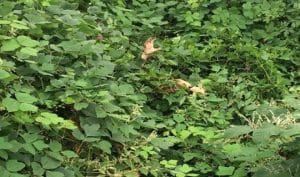 Contributed by Monica Holston, Project Manager, PPM Consultants
Contributed by Monica Holston, Project Manager, PPM Consultants
If you’re from the southeastern U.S. or have spent any amount of time travelling through the South, it’s almost a guarantee that you have observed an area of land that has been over-taken by Kudzu. For those of you who are unfamiliar with the highly invasive plant, Kudzu (Pueraria montana var.lobata) is a fast-growing vine that has earned the nickname “the vine that ate the South.” It is native to East Asia, particularly China and Japan, and it was first introduced to the U.S. in the late 1800’s where it was touted for its blooms and sturdy vines. In the 1900’s, it was also promoted as a great tool for soil erosion, but I don’t believe anyone could have foreseen the catastrophic impact it would later have on native fauna. In the later half of the 20th century, Kudzu gained notoriety for its negative impacts on the environment, agriculture, and infrastructure in regions where it has become established.
PPM has a number of project sites that are overrun with Kudzu; and when you’re attempting to find a groundwater monitoring well, it feels like you’re hunting for a needle in a haystack. The only difference is, with this haystack, you’re likely to encounter a number of animals (snakes, rats, spiders, etc.) that call it home. Not to mention if you were to fall down, you may need help to simply get out of the tangled web of vines crisscrossing the ground and covering everything in sight like a horrible green blanket.
Here are some of the problems associated with Kudzu:
 Invasive Nature: Kudzu is highly invasive and can grow at a rapid rate, covering and smothering native vegetation, trees, and other plants. Its ability to outcompete and shade out other plants reduces biodiversity and can lead to the decline of native species.
Invasive Nature: Kudzu is highly invasive and can grow at a rapid rate, covering and smothering native vegetation, trees, and other plants. Its ability to outcompete and shade out other plants reduces biodiversity and can lead to the decline of native species.- Disruption of Ecosystems: When kudzu takes over an area, it disrupts the natural balance of ecosystems. Native wildlife that depend on native vegetation for food and shelter can be negatively affected, as their habitat is altered or destroyed by kudzu.
- Agricultural and Forestry Threat: Kudzu can infest agricultural fields, pastures, and forests, reducing crop yields, forage availability for livestock, and overall productivity. The vine can also climb trees and cause damage to the forest canopy.
- Erosion Control Issues: While it was initially introduced in the United States in the 1930s as a potential solution for erosion control, kudzu has since become a major problem in this regard. Its rapid growth can cover hillsides and banks, but it eventually dies back in the winter, leaving soil exposed to erosion.
- Infrastructure Damage: Kudzu can grow over and cover structures such as buildings, telephone poles, and road signs. Its weight can damage these structures over time, and the cost of removing kudzu from infrastructure can be significant.
- Costly Management: Controlling and managing kudzu infestations require significant resources, including labor and herbicides. Due to its aggressive growth, eradicating kudzu from an area can be a long and costly process.
- Difficult to Eradicate: Kudzu has a deep root system and can regrow from root fragments, making it challenging to completely eradicate once established.
In summary, once thought of as a solution to soil erosion, kudzu ‘s invasive nature has had a devastating impact on native plants and even exacerbated soil erosion in some areas.
Across PPM’s southeastern footprint, we have numerous project sites that we have to spend extra time and money controlling the Kudzu, simply to locate wells and ensure our staff have safe access to the property. So, if you own land and happen to see any Kudzu, be kind and kill it!
Links to other articles or websites on this topic are provided below.
Kudzu: The Invasive Vine that Ate the South | TNC (nature.org)


 Invasive Nature: Kudzu is highly invasive and can grow at a rapid rate, covering and smothering native vegetation, trees, and other plants. Its ability to outcompete and shade out other plants reduces biodiversity and can lead to the decline of native species.
Invasive Nature: Kudzu is highly invasive and can grow at a rapid rate, covering and smothering native vegetation, trees, and other plants. Its ability to outcompete and shade out other plants reduces biodiversity and can lead to the decline of native species.